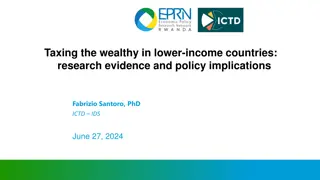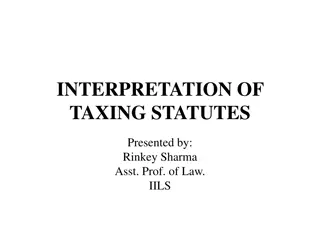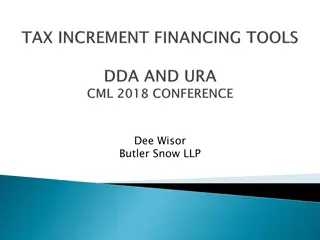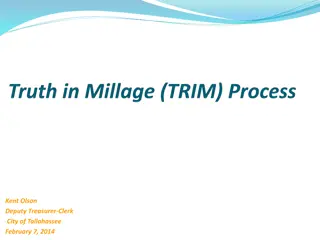
Taxation: Types, Brackets, and Filing Guide
Explore the intricacies of taxation, including various tax types like progressive and regressive taxes, understanding tax brackets, and filing your taxes correctly to avoid penalties. Learn about the IRS, tax evasion, and tax avoidance practices to ensure compliance.
Download Presentation

Please find below an Image/Link to download the presentation.
The content on the website is provided AS IS for your information and personal use only. It may not be sold, licensed, or shared on other websites without obtaining consent from the author. If you encounter any issues during the download, it is possible that the publisher has removed the file from their server.
You are allowed to download the files provided on this website for personal or commercial use, subject to the condition that they are used lawfully. All files are the property of their respective owners.
The content on the website is provided AS IS for your information and personal use only. It may not be sold, licensed, or shared on other websites without obtaining consent from the author.
E N D
Presentation Transcript
Taxing A tax (a payment imposed on a taxpayer by a governmental unit.) => Incoming tax is called revenue. The greatest % of revenue comes from income tax. o 16thAmendment: Allowed for income tax (a direct tax on an individual s income).
Types of Taxes Progressive tax: takes a larger share of income as the amount of income grows. (Ability-to-pay principle: the belief that taxes should be levied according to one s ability to pay.) o What issues do you see with this principle? Good or bad? o Someone with a lower income may only pay 15% while someone with a higher income may pay 28%. Regressive tax: takes a smaller share of one s income as the amount of income grows. o Example: Sales tax- If one pays $500 for sales tax on a car purchase, an individual with $50,000 income pays X% while an individual with $20,000 income pays Y%. Proportional tax (flat tax): a tax rate that stays the same regardless of one s income.
Tax Brackets Which department is in charge of federal tax collecting? o IRS or Internal Revenue Service (Treasury Department) o What type of tax is income tax? o A tax is applied to an income range or tax bracket Taxable income up to $9,075 $36,900 $89,350 $186,000 $405,100 $406,750 Over 406,750 Marginal Tax Rate 10% 15% 25% 28% 33% 35% 39.6% 1) What would you pay if you made $45,000? What is the overall rate? 2) What would you pay if you made $350,000? What is the overall rate? 3) What would you pay if you made $650,000? What is the overall rate?
IRS Paying your taxes is based on voluntary compliance (all citizens prepare and file tax returns on their own). Failure to do so can result in penalty. Willful failure is tax evasion which is a crime punishable by fine and/or imprisonment. Tax avoidance is taking all of the available deductions to reduce taxes. The IRS can audit you to determine if you have paid correctly. audit: an official inspection of one s accounts (in this case, to determine if you have paid in-full)
Filing Taxes Filing status: describes your tax-filing group (single, married, head of house (must provide a home for a dependent), widow ) Exemptions are an amount you may subtract from your income for each person who depends on your income to live (each exemption reduces your taxable income and thus your total tax). o A dependent is someone who you pay for half of living expenses (children, elderly, spouse ) Gross income is all of the taxable income you receive during a year. o Earned income: wages, salaries, tips, business income o Unearned income: interest, dividends, alimony, social security , scholarships/grants, prizes (you receive for passive activity) o Non-taxable income: child support, gifts, inheritances, life insurance benefits, veteran s benefits
Tax Benefits Benefits: o Itemized deductions: expenses you can subtract from gross income to determine your taxable income o Standard deduction: certain deductions that are based off of filing status => children ~$3900/child, married v. head of household has a standard deduction o Tax credit: a deduction on taxes owed. If you have a tax credit of $100 and you owe $800, you now owe $700.
Tax Forms Tax forms: 1040: If you make over $100,000 (required) or if your itemized reductions are more than your standard deductions, use the 1040. 1040A: If you have some deductions and credits, but a smaller salary use 1040A. 1040EZ: If you have no deductions or credit and make less than $100,000, use the 1040EZ.






















